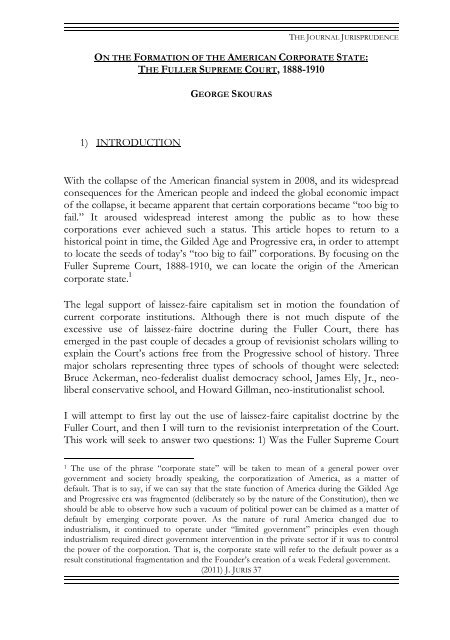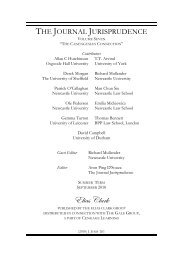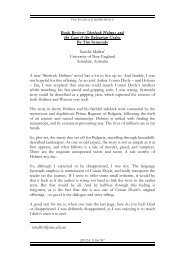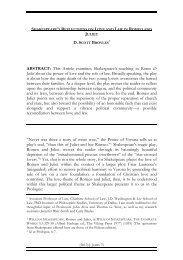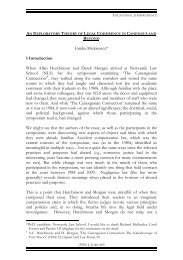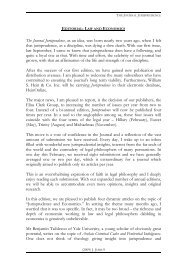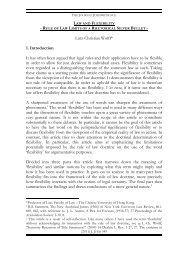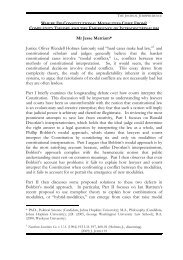On the Formation of the American Corporate State - The Journal ...
On the Formation of the American Corporate State - The Journal ...
On the Formation of the American Corporate State - The Journal ...
Create successful ePaper yourself
Turn your PDF publications into a flip-book with our unique Google optimized e-Paper software.
SKOURAS ON THE FORMATION OF THE AMERICAN CORPORATE STATE:THE FULLER SUPREME COURT, 1888-1910accomplish this? It gave it a substantive economic interpretation. 15 It relied on<strong>the</strong> treatises <strong>of</strong> Cooley and Tiedeman 16 to help fortify <strong>the</strong> protection <strong>of</strong>property. Also, Justice Stephen Field 17 served as one <strong>of</strong> <strong>the</strong> key players on <strong>the</strong>Court defending property rights.<strong>The</strong> Reconstruction Amendments opened <strong>the</strong> door for <strong>the</strong> Court to use <strong>the</strong>Due Process Clause as a policy instrument for an emerging Industrial America.<strong>The</strong> Court redirected <strong>the</strong> Fourteenth Amendment from helping <strong>the</strong> formerslaves 18 to helping build <strong>the</strong> corporate state. 19 And, it became a given by <strong>the</strong>restrictions that apply to <strong>the</strong> federal government. <strong>The</strong> Due Process Clause traces its origin to<strong>the</strong> Magna Carta. For additional research on <strong>the</strong> Fourteenth Amendment, See, CHESTERANTIEAU, THE ORIGINAL UNDERSTANDING OF THE FOURTEENTH AMENDMENT (1981);MICHAEL K. CURTIS, NO STATE SHALL ABRIDGE: THE FOURTEENTH AMENDMENT AND THEBILL OF RIGHTS (1986); WILLIAM E. NELSON, THE FOURTEENTH AMENDMENT: FROMPOLITICAL PRINCIPLE TO JUDICIAL DOCTRINE (1988).14 MICHAEL KAMMEN, A MACHINE THAT WOULD GO OF ITSELF: THE CONSTITUTION INAMERICAN CULTURE 7 (1987); See generally, SANFORD LEVINSON, OUR UNDEMOCRATICCONSTITUTION: WHERE THE CONSTITUTION GOES WRONG (2006) (a broader critique on <strong>the</strong>undemocratic nature <strong>of</strong> <strong>the</strong> Constitution).15 WILLIAM M. WIECEK, LIBERTY UNDER LAW: THE SUPREME COURT IN AMERICAN LIFE 116(1988) (“Bradley’s dissent in Slaughterhouse was more far-reaching. In a brief passage, heconjured up <strong>the</strong> doctrine <strong>of</strong> substantive due process out <strong>of</strong> <strong>the</strong> natural rights tradition…<strong>the</strong>transformation <strong>of</strong> <strong>the</strong> concept <strong>of</strong> property from tangible objects (e.g., land, wagons, horses) tointangible rights and expectations, such as <strong>the</strong> abstract right to sell one’s labor or <strong>the</strong>expectation <strong>of</strong> pr<strong>of</strong>it. [P]rocedural due process enabled courts to oversee <strong>the</strong> rules by whichtrials were conducted. Substantive due process, on <strong>the</strong> o<strong>the</strong>r hand, protected property rightsfrom legislative impairment.”)16 JAMES W. ELY, THE CHIEF JUSTICESHIP OF MELVILLE W. FULLER 1888-1910, at 63-64(1995); See also, CHRISTOPHER G. TIEDEMAN, A TREATISE ON THE LIMITATIONS OF POLICEPOWER IN THE UNITED STATES CONSIDERED FROM BOTH A CIVIL AND CRIMINALSTANDPOINT (Union, N.J.: Law Exchange 2001) (1886); THOMAS M. COOLEY, TREATISE ONTHE CONSTITUTIONAL LIMITATIONS WHICH REST UPON THE LEGISLATIVE POWER OF THESTATES (Union, N.J.: Lawbook Exchange 1998) (1868); James W. Ely, Jr., Economic Due ProcessRevisited, 44 VAND. L. REV. 213 (1991); Louise A. Halper, Christopher G. Tiedeman, ‘Laissez-FaireConstitutionalism’ and <strong>the</strong> Dilemmas <strong>of</strong> Small-Scale Property in <strong>the</strong> Gilded Age, 51 OHIO ST. L. J. 1249(1990); See generally, GEORGE SKOURAS, TAKING LAW AND THE SUPREME COURT: JUDICIALOVERSIGHT OF THE STATE’S ACQUISITION, USE, AND CONTROL OF PRIVATE PROPERTY (1998)(on <strong>the</strong> history <strong>of</strong> <strong>the</strong> police power and regulatory takings law).17 CARL BRENT SWISHER, STEPHEN J. FIELD: CRAFTSMAN OF THE LAW (1930); Charles W.McCurdy, Justice Field and <strong>the</strong> Jurisprudence <strong>of</strong> Government-Business Relations: Some Parameters <strong>of</strong> Laissez-Faire Constitutionalism, 1863-1897, 61 JOURNAL OF AMERICAN HISTORY 970 (1975); HOWARDFURER, THE FULLER COURT 1888-1910 (1986). PAUL KENS, JUSTICE STEPHEN FIELD:SHAPING AMERICAN LIBERTY FROM THE GOLD RUSH TO THE GILDED AGE (1997).18 Civil Rights Cases, 109 U.S. 3 (1883) (Civil rights for blacks were ignored and economic rightsfor <strong>the</strong> emerging corporation were privileged); See also, Plessy v. Ferguson, 163 U.S. 537 (1896)(<strong>The</strong> Fourteenth Amendment does not prohibit private citizens from discriminating againstblacks, with regard to hotel, <strong>the</strong>ater, or railroad accommodations. <strong>The</strong> Court promulgated <strong>the</strong>(2011) J. JURIS 40
THE JOURNAL JURISPRUDENCEsocieties. Since America lacked a feudal past <strong>the</strong>y argued, it lacked <strong>the</strong> classstructure prevalent in Europe. <strong>The</strong>se consensus historians attempted to recast<strong>the</strong> <strong>American</strong> past by stripping away slavery, violence, class conflict,imperialism, and native liquidations in order to present a clean history <strong>of</strong><strong>American</strong> development. 33 <strong>The</strong> consensus historians were reacting to an earliergeneration <strong>of</strong> Progressive historians---Beard, Parrington, Schlesinger, andTurner. 34 <strong>The</strong>y believe <strong>the</strong>se Progressive historians painted a picture <strong>of</strong>America with too many conflict scenes. And <strong>the</strong> Progressive movement 35 ingeneral was mostly a middle class movement that wanted to ameliorate <strong>the</strong>impact <strong>of</strong> large industry on society. 36 <strong>The</strong> Progressives 37 did not want todismantle corporations but ra<strong>the</strong>r to bring <strong>the</strong>m under <strong>the</strong> control <strong>of</strong>government via regulation. 38 And because Beard 39 emphasized economic andclass analysis, he became a favorite target <strong>of</strong> <strong>the</strong> consensus historians. Although<strong>the</strong>se Progressives historians left gaps unexplained in <strong>the</strong> documentary1989); ISAIAH BERLIN, FOUR ESSAYS ON LIBERTY (1969); LIBERALISM AND ITS CRITICS(Michael Sandel, ed. 1984); DAVID JOHNSTON, THE IDEA OF A LIBERAL THEORY: A CRITIQUEAND RECONSTRUCTION (1994) (for a modern defense <strong>of</strong> liberalism) and DAVID HARVEY, ABRIEF HISTORY OF NEOLIBERALISM (2005).33 <strong>The</strong>se historians believe in <strong>American</strong> exceptionalism. However, by emphasizing a “clean”history, <strong>the</strong>y overlooked <strong>the</strong> animal side <strong>of</strong> <strong>the</strong> human being. Figures such as Darwin, Marx,and Freud had <strong>the</strong> insight that animality is at <strong>the</strong> core <strong>of</strong> our species. <strong>The</strong> primal drives thatmove <strong>the</strong> human animal are not “conscious” or “rational” forces but instinctual drives and <strong>the</strong>unconscious. See, DAVID RIESMAN, INDIVIDUALISM RECONSIDERED 206-245 (1954) (inparticular see <strong>the</strong> chapter on: “Authority and Liberty in <strong>the</strong> Structure <strong>of</strong> Freud’s Thought”); Seegenerally, SIGMUND FREUD, CIVILIZATION AND ITS DISCONTENTS (W.W. Norton & Comp.,1989) (1930).34 CHARLES A. BEARD, AN ECONOMIC INTERPRETATION OF THE CONSTITUTION OF THEUNITED STATES (<strong>The</strong> Free Press, 1986) (1913). V. L. PARRINGTON, MAIN CURRENTS OFAMERICAN THOUGHT (University <strong>of</strong> Oklahoma Press, 1987) (1927). FREDERICK JACKSONTURNER, THE FRONTIER IN AMERICAN HISTORY (<strong>The</strong> University <strong>of</strong> Michigan Press, 2006)(1893). ARTHUR M. SCHLESINGER, SR., THE NEW VIEWPOINTS IN AMERICAN HISTORY (1922).35 In general Progressive activists and intellectuals were from a middle class background andwere interested in reform ra<strong>the</strong>r than revolution.36 <strong>On</strong>e <strong>of</strong> <strong>the</strong> early Progressives Herbert Croly accused <strong>the</strong> Fuller Court <strong>of</strong> usurping <strong>the</strong> policymakingrole <strong>of</strong> <strong>the</strong> legislature through <strong>the</strong>ir interpretation <strong>of</strong> <strong>the</strong> Due Process Clause; See,HERBERT CROLY, PROGRESSIVE DEMOCRACY (Oxford University Press, 1961) (1915).37 SIDNEY FINE, LAISSEZ FAIRE AND THE GENERAL WELFARE: A STUDY OF CONFLICT INAMERICAN THOUGHT 1865-1901 (1964) (in particular, his chapter on “Laissez Faire Becomes<strong>the</strong> Law <strong>of</strong> <strong>the</strong> Land,” at 126-164); See generally, CLARENCE B. CARSON, THE GROWTH OFAMERICA 1878-1928 (1985) (for a more conservative/libertarian reading <strong>of</strong> <strong>the</strong> Gilded Age andProgressive Era period).38 GABRIEL KOLKO, TRIUMPH OF CONSERVATISM (1977).39 CHARLES A. BEARD, AN ECONOMIC INTERPRETATION OF THE CONSTITUTION OF THEUNITED STATES; see also, RAYMOND SEIDELMAN, DISENCHANTED REALISTS: POLITICALSCIENCE AND THE AMERICAN CRISIS 1884-1984, at 60-100 (1985) (Chapter Three, “Science asMuckraking: <strong>The</strong> Cult <strong>of</strong> Realism in <strong>the</strong> Progressive Era”).(2011) J. JURIS 45
SKOURAS ON THE FORMATION OF THE AMERICAN CORPORATE STATE:THE FULLER SUPREME COURT, 1888-1910evidence 40 or were later found to have been mistaken on one point or ano<strong>the</strong>r,never<strong>the</strong>less, <strong>the</strong>y attempted to note <strong>the</strong> role <strong>of</strong> economics in <strong>the</strong> establishment<strong>of</strong> political structures.Since many people <strong>of</strong> <strong>the</strong> 1950s were uncomfortable with <strong>the</strong> use <strong>of</strong> class 41analysis, it was helpful for <strong>the</strong>se consensus historians to find in <strong>American</strong>society evidence <strong>of</strong> non-class based institutions. It was important to findinstitutions that reflected <strong>American</strong> freedom ra<strong>the</strong>r than economic exploitation,slavery, and o<strong>the</strong>r less democratic features <strong>of</strong> <strong>American</strong> history. By looking at<strong>the</strong> reportage <strong>of</strong> <strong>the</strong> muckrakers, 42 during <strong>the</strong> industrialization <strong>of</strong> America, onecan see a tooth and claw economic doctrine in action--- that left millions <strong>of</strong><strong>American</strong> exposed to waste, filth, dangerous working conditions, low pay,violence, segregation, etc. <strong>The</strong> consensus historians took note <strong>of</strong> thisunfortunate state <strong>of</strong> affairs during critical points in <strong>American</strong> history, but <strong>the</strong>yfelt it should not color <strong>the</strong> whole <strong>of</strong> <strong>American</strong> history. <strong>The</strong>y were sure that<strong>the</strong>re existed pockets <strong>of</strong> history that illustrate <strong>the</strong> positive aspects <strong>of</strong> <strong>American</strong>freedom.<strong>The</strong> liberal vision <strong>of</strong> America as presented by <strong>the</strong> 1950s consensus historiansstarted to be questioned in 1960s and 1970s by an emerging ideological school40 ROBERT E. BROWN, CHARLES BEARD AND THE CONSTITUTION: A CRITICAL ANALYSIS OF“AN ECONOMIC INTERPRETATION OF THE CONSTITUTION” (1956). FORREST MCDONALD,WE THE PEOPLE: THE ECONOMIC ORIGINS OF THE CONSTITUTION (1958). MERRILL JENSEN,THE NEW NATION: A HISTORY OF THE UNITED STATES DURING THE CONFEDERATION 1781-1789 (1950) (attempted to preserve <strong>the</strong> Progressive understanding <strong>of</strong> <strong>the</strong> Revolutionary erawhen its premises were being attacked).41 SAMUEL P. HAYS, THE RESPONSE TO INDUSTRIALISM 1885-1914, at 37 (1957) (“<strong>The</strong> starkreality <strong>of</strong> social conflict deeply stunned <strong>American</strong>s who had cherished <strong>the</strong> view that classdivisions did not exist in <strong>the</strong>ir country”); See also, NORMAN POLLACK, THE POPULISTRESPONSE TO INDUSTRIAL AMERICA (1966); John WHITECLAY CHAMBERS II, THE TYRANNYOF CHANGE: AMERICA IN THE PROGRESSIVE ERA 1890-1920 (1992); See also, JACK BEATTY,THE TRIUMPH OF MONEY IN AMERICA 1865-1900, at 200 (Beatty says: “In “<strong>The</strong> Owners <strong>of</strong><strong>the</strong> United <strong>State</strong>s,” a writer in <strong>the</strong> Forum, extrapolating from <strong>the</strong> 1880 census, figured that25,000 people owned half <strong>the</strong> wealth and 250,000, 75 to 80 percent <strong>of</strong> it. “Who owns <strong>the</strong>United <strong>State</strong>s?” he asked. “<strong>The</strong> USA is practically owned by less than 250,000 persons.” Using<strong>the</strong> 1890 census, a contributor to POLITICAL SCIENCE QUARTERLY calculating “<strong>The</strong>Concentration <strong>of</strong> Wealth” found that “4,047 families possess as much as do 11,593,887families.” “This result,” he wrote, “seems almost incredible””).42 Here are some <strong>of</strong> <strong>the</strong> Muckrakers <strong>of</strong> <strong>the</strong> period: LINCOLN STEFFANS, THE SHAME OF THECITIES (1904). UPTON SINCLAIR, THE JUNGLE (Penguin Classics, 1985). JACOB RIIS, HOW THEOTHER HALF LIVES: STUDIES AMONG THE TENEMENTS OF NEW YORK (1906). IDA TARBELL,THE HISTORY OF THE STANDARD OIL COMPANY (Dover Publications, 2003).(2011) J. JURIS 46
THE JOURNAL JURISPRUDENCE<strong>of</strong> historians (Bailyn, Wood, and Pocock). 43 This school believes Hartz overemphasizesliberalism. <strong>The</strong> ideological historians believe liberal consensushistorians neglect <strong>the</strong> “republican” 44 aspect <strong>of</strong> <strong>American</strong> development. And<strong>the</strong>y saw <strong>the</strong> New Deal case law 45 serving as a corrective to excessive economicliberty.<strong>The</strong> 1990s generation <strong>of</strong> revisionists, Bruce Ackerman, James W. Ely, Jr., andHoward Gillman, is making ano<strong>the</strong>r attempt to free <strong>the</strong> Fuller Court from <strong>the</strong>grip <strong>of</strong> Progressivism. During <strong>the</strong> 1990s <strong>the</strong>se three prominent scholars soughtto revise <strong>the</strong> Progressive interpretation <strong>of</strong> <strong>the</strong> Fuller Court. <strong>The</strong>y representthree schools <strong>of</strong> thought: 1) Neo-Federalism (liberal republicanism, dualist)School---Ackerman, 2) Classic-liberal conservative School---Ely, and 3) Neo-Institutionalist School---Gillman. <strong>The</strong>y object to <strong>the</strong> Legal Realist 46 andProgressive interpretation <strong>of</strong> <strong>the</strong> Court and post hoc attacks on its formalistjurisprudence. <strong>The</strong>y feel that <strong>the</strong> formalist jurisprudence used by <strong>the</strong> FullerCourt was fully consistent with <strong>the</strong> spirit <strong>of</strong> <strong>the</strong> age. Be it electoral primacy(Ackerman), natural rights (Ely), or institutional constraints (Gillman), I hopeto show that <strong>the</strong>se revisionists are mistaken in treating <strong>the</strong> Court as a legal bodyra<strong>the</strong>r than a political body. <strong>The</strong>y want to re-contextualize <strong>the</strong> Fuller Court asbeing in <strong>the</strong> flow and spirit <strong>of</strong> <strong>the</strong> age. However, looking at <strong>the</strong> matter from aCritical Legal Studies School perspective, <strong>the</strong> Court was not interpreting lawbut making law. <strong>The</strong> Critical School <strong>of</strong> thought, borrows an important elementfrom <strong>the</strong> Realists, 47 which suggests that law is politics by o<strong>the</strong>r means.43GORDON WOOD, THE CREATION OF THE AMERICAN REPUBLIC 1776-1797 (1969); BERNARDBAILYN, THE IDEOLOGICAL ORIGINS OF THE AMERICAN REVOLUTION (1967); J.G.A.POCOCK, THE MACHIAVELLIAN MOMENT: THE FLORENTINE POLITICAL THOUGHT AND THEATLANTIC REPUBLICAN TRADITION (1975).44 Republicanism as in small “r” Jeffersonian or Machiavellian variation <strong>of</strong> republicanism, not<strong>the</strong> modern Republican Party sense.45Cases that helped curtail <strong>the</strong> Gilded Age and Progressive era Court’s rulings: Home Building &Loan Association v. Blaisdell, 280 U.S. 398 (1934); Nebbia v. New York, 291 U.S. 502 (1934); WestCoast Company v. Parrish, 300 U.S. 379 (1937); National Labor Relations Board v. Jones & LaughlinSteel Corp., 301 U.S. 1 (1937); United <strong>State</strong>s v. F. W. Darby Lumber Company, 312 U.S. 100 (1941);Wickard v. Filburn, 317 U.S. 111 (1942).46 In short, Legal Realism is a legal philosophy that challenges <strong>the</strong> view that law is anautonomous and independent practice free from <strong>the</strong> personal views <strong>of</strong> judges. It challenges <strong>the</strong>view that judges can be objective and free from personal, political, social, economic, andcultural beliefs and can objectively judge laws and rules free from <strong>the</strong>se human influences.47 E.g., Realisms was not a unified philosophy and involved many variations. Here are some <strong>of</strong><strong>the</strong> Legal Realists: Oliver Wendell Holmes, Roscoe Pound, Jerome Frank, Karl Llewellyn,Robert Hale, Felix Cohen, Louis Brandeis, Benjamin Cardozo, Felix Frankfurter, William O.Douglas, etc.(2011) J. JURIS 47
SKOURAS ON THE FORMATION OF THE AMERICAN CORPORATE STATE:THE FULLER SUPREME COURT, 1888-1910Fur<strong>the</strong>r, <strong>the</strong> revisionists are mistaken in viewing America from <strong>the</strong> prism <strong>of</strong>liberal democracy. And although <strong>the</strong>se revisionists recognize that America isnot a class free country, <strong>the</strong>y seem to circumscribe economic primacy as a keycomponent <strong>of</strong> class structure. It has been taken for granted that America is anopen society with fluid class structure. <strong>The</strong>re are no fixed classes in America.However true this assertion seems to be, it should not be taken as unqualifiedlytrue. <strong>The</strong> philosophy <strong>of</strong> individualism, along with <strong>the</strong> consolidation <strong>of</strong>corporate power, has closed <strong>of</strong>f <strong>the</strong> upward movement for <strong>the</strong> majority <strong>of</strong><strong>American</strong>s from <strong>the</strong> start <strong>of</strong> <strong>American</strong> history.Given <strong>the</strong> Progressive interpretation <strong>of</strong> viewing <strong>the</strong> Fuller Court as probusinessand anti-labor, pro-capital power and limited government, can <strong>the</strong>serevisionists explain <strong>the</strong> Court’s behavior?a) <strong>The</strong> Neo-Federalist (liberal republican, dualist) syn<strong>the</strong>sis School---Bruce AckermanAckerman represents a School <strong>of</strong> neo-federalism, liberal republicanism 48 thatattempts to syn<strong>the</strong>size liberalism and republicanism, Locke and Machiavelli---he48 BRUCE ACKERMAN, 1WE THE PEOPLE: FOUNDATIONS (1991) and 2WE THE PEOPLE:TRANSFORMATIONS (1998); Ackerman drawing support for his Ne<strong>of</strong>ederalism <strong>the</strong>sis in: THEFEDERALIST PAPERS; GORDON WOOD, THE CREATION OF THE AMERICAN REPUBLIC 1776-1797 (1969); EDMUND S. MORGAN, INVENTING THE PEOPLE: THE RISE OF POPULARSOVEREIGNTY IN ENGLAND AND AMERICA (1988); HANNAH ARENDT, ON REVOLUTION(1963); BERNARD BAILYN, THE IDEOLOGICAL ORIGINS OF THE AMERICAN REVOLUTION(1967); J.G.A. POCOCK, THE MACHIAVELLIAN MOMENT: THE FLORENTINE POLITICALTHOUGHT AND THE ATLANTIC REPUBLICAN TRADITION (1975); Frank Michelman, Law’sRepublic, 97 YALE L.J 1493 (1988); Cass Sunstein, Beyond <strong>the</strong> Republican Revival, 97 YALE L.J 1539(1988) and THE PARTIAL CONSTITUTION (1993); Suzanna Sherry, Responsible Republicanism:Educating for Citizenship, 62 U. CHI. L. REV. 131 (1995); critics <strong>of</strong> Ackerman work include:Michael Les Benedict, History and Constitutional <strong>The</strong>ory: Reflections on Ackerman, Reconstruction, and<strong>the</strong> Transformation <strong>of</strong> <strong>the</strong> <strong>American</strong> Constitution, 108 YALE L.J 2011 (1999) and Laissez-faire andLiberty: A Reevaluation <strong>of</strong> <strong>the</strong> Meaning and Origin <strong>of</strong> Laissez-Faire Constitutionalism, 3 LAW & HISTORYREV. 243-331 (1985); Miriam Galston and William A. Galston. Reason, Consent, and <strong>the</strong> U.S.Constitution: Bruce Ackerman's "We <strong>the</strong> People", 104 ETHICS 446 (1994); Thomas Landry,Ackermania!: Who Are We <strong>the</strong> People?, 47 U. MIAMI L. REV. 267 (1992); William Fisher, <strong>The</strong> Defects<strong>of</strong> Dualism, U. CHI. L. REV. 955 (1992); Michael Klarman, Constitutional Fact/Constitutional Fiction:A Critique <strong>of</strong> Bruce Ackerman’s <strong>The</strong>ory <strong>of</strong> Constitutional Moments, 44 STAN. L. REV. 759 (1992); EbenMoglen, <strong>The</strong> Incomplete Burkean: Bruce Ackerman’s Foundation for Constitutional History, 5 YALE J.L.& HUMAN. 531 (1993); Randy E. Barnett, Constitutional Legitimacy, 103 COLUM. L. REV. 111(2003); David E. Bernstein, Lochner Era Revisionism, Revised: Lochner and <strong>the</strong> Origins <strong>of</strong> FundamentalRights Constitutionalism, 82 GEO. MASON L. REV. 1 (2003); o<strong>the</strong>r scholars questioning <strong>the</strong> ne<strong>of</strong>ederalistapproach: Ahkil Reed Amar, A Few Thoughts on Constitutionalism, Textualism, andPopulism, 65 FORDHAM L. REV. 1657 (1997), <strong>The</strong> Bill <strong>of</strong> Rights as a Constitution, 100 YALE L.J.(2011) J. JURIS 48
THE JOURNAL JURISPRUDENCEattempts in his revisionism to syn<strong>the</strong>size <strong>the</strong> liberal and republican schools <strong>of</strong>thought to produce a neo-federalism (dualist democracy). He views <strong>the</strong> FullerCourt as following <strong>the</strong> election returns. According to him, <strong>the</strong> repudiation <strong>of</strong>laissez-faire doctrine was not prevalent until <strong>the</strong> New Deal. 49 So it is not fair toblame <strong>the</strong> Fuller Court for endorsing laissez-faire policies.Clearly, Ackerman, wedded to <strong>the</strong> rule <strong>of</strong> law, misses asking <strong>the</strong> broaderquestion: whose law? Working within <strong>the</strong> system leads Ackerman to becaptivated and captured by <strong>the</strong> period he seeks to analyze. Ackerman explains<strong>the</strong> period thus:To <strong>the</strong> contrary: <strong>the</strong> Justices had just lived through <strong>the</strong> failed Populisteffort to mobilize <strong>the</strong> <strong>American</strong> people against <strong>the</strong> evils <strong>of</strong> laissez-fairecapitalism---a movement that climaxed with <strong>the</strong> nomination <strong>of</strong> WilliamJennings Bryan as <strong>the</strong> Democratic candidate for <strong>the</strong> Presidency in 1896.Ra<strong>the</strong>r than leading to a Rooseveltian transformation, Bryan’s nominationserved only to catalyze a decisive popular counterreaction on behalf <strong>of</strong>William McKinley and <strong>the</strong> Republican Party. 50What he is trying to say is this: <strong>the</strong> role <strong>of</strong> property in <strong>American</strong> society wassettled by <strong>the</strong> 1896 election. <strong>The</strong> People elected a President that favoredbusiness and property over <strong>the</strong> Populist and Progressive agenda <strong>of</strong> farmers andworkers. So <strong>the</strong>re was nothing unusual about <strong>the</strong> Court’s treatment <strong>of</strong> labor ingeneral and <strong>the</strong> Lochner 51 decision in particular. It simply affirmed <strong>the</strong> right to1131 (1991) and THE BILL OF RIGHTS: CREATION AND RECONSTRUCTION (2000); OWEN FISS,TROUBLED BEGINNING OF THE MODERN STATE 1888-1910 (1993); SANFORD LEVINSON, OURUNDEMOCRATIC CONSTITUTION: WHERE THE CONSTITUTION GOES WRONG (AND HOW WETHE PEOPLE CAN CORRECT IT (2006); o<strong>the</strong>r scholars using critical and realist analysischallenging <strong>the</strong> revisionists:WILLIAM EDWARD LEUCHTENBURG, THE SUPREME COURTREBORN: THE CONSTITUTIONAL REVOLUTION IN THE AGE OF ROOSEVELT (1996); LAURAKALMAN, THE STRANGE CAREER OF LEGAL LIBERALISM (1996); MORTON J. HOROWITZ, THETRANSFORMATION OF AMERICAN LAW (1979); CHRISTOPHER TOMLINS, LAW, LABOR, ANDIDEOLOGY IN THE EARLY AMERICAN REPUBLIC (1993).49 Ackerman, WE THE PEOPLE: FOUNDATIONS at 100: (“If, <strong>the</strong>n, something was fundamentallywrong with Lochner, it has to do with <strong>the</strong> particular way middle republican courts conceptualized<strong>the</strong> nature <strong>of</strong> fundamental rights. It is here, however, where anachronism distorts modernvision in condemning <strong>the</strong> middle republic’s emphasis on private property and freedom <strong>of</strong>contract. Given <strong>the</strong> popular repudiation <strong>of</strong> laissez-faire during <strong>the</strong> New Deal, it is no longerright for modern courts to interpret constitutional liberty in free market terms. But before <strong>the</strong>1930’s, things looked very different. Even during <strong>the</strong> early republic, <strong>the</strong> courts had marked outcontract as a domain <strong>of</strong> freedom peculiarly appropriate for national protection.”)50 Ackerman, WE THE PEOPLE: FOUNDATIONS at 101.51 Lochner v. New York, 198 U.S. 45 (1905) (<strong>The</strong> Court upheld <strong>the</strong> freedom <strong>of</strong> contract doctrine,that <strong>the</strong> <strong>State</strong> had no business interfering in privately agreed to contracts); See also, PAUL KENS,(2011) J. JURIS 49
SKOURAS ON THE FORMATION OF THE AMERICAN CORPORATE STATE:THE FULLER SUPREME COURT, 1888-1910contract without government intervention. So those later generations <strong>of</strong>intellectuals that want to condemn <strong>the</strong> Lochner-era are mistaken because <strong>the</strong>People spoke, and <strong>the</strong>y decisively chose McKinley over Bryan.What is missing here is <strong>the</strong> critical element that leaves a number <strong>of</strong> questionsand gaps in <strong>the</strong> literature as to why <strong>the</strong> Supreme Court was justified in reading<strong>the</strong> Fourteenth Amendment as pro-business and anti-labor provision based onelection returns. Who is ‘We <strong>the</strong> People’ that Ackerman has in mind? 52 Does itmatter even if ‘we are people’ capable <strong>of</strong> empowering such a system? Couldpatronage interfere with <strong>the</strong> goals <strong>of</strong> ‘we <strong>the</strong> people’? Does it matter whe<strong>the</strong>rgiant corporation are able to displacing <strong>the</strong>se laws if <strong>the</strong>se laws do not suit <strong>the</strong>irinterests? Does <strong>the</strong> existence <strong>of</strong> a Spoils System 53 matter as far as elections and<strong>the</strong> electorate is concerned? Ackerman seems to set <strong>the</strong>se questions aside infavor <strong>of</strong> <strong>the</strong> big question: was an election held and who was <strong>the</strong> victor in thatelection?<strong>The</strong> Fuller Court according to Ackerman’s dualist constitutional model mustreconcile two different historical periods. It must reconcile <strong>the</strong> Founder’sConstitution with a post-Civil War Constitution. However, this view is notplausible because <strong>the</strong> Fuller Court used <strong>the</strong> Due Process Clause, not toreconcile <strong>the</strong> Founding and Reconstruction, but to privilege <strong>the</strong> Justice’svalues, preferences, and politics. What <strong>the</strong> People wanted was beside <strong>the</strong> point.Ra<strong>the</strong>r than embody <strong>the</strong> values <strong>of</strong> <strong>the</strong> <strong>American</strong> people based on electionresults, <strong>the</strong> Fuller Court used <strong>the</strong> Due Process Clause to privilege those valuesthat were embedded in <strong>the</strong> Lockean philosophy <strong>of</strong> property. Ackerman simplyaccepts <strong>the</strong> idea that election returns reflect <strong>the</strong> will <strong>of</strong> <strong>the</strong> <strong>American</strong> people.<strong>The</strong> Critical Legal Studies School 54 and Legal Realism question whe<strong>the</strong>r <strong>the</strong>LOCHNER V. NEW YORK: ECONOMIC REGULATION ON TRIAL (1998); See also, G. EDWARDWHITE, Revisiting Substantive Due Process and Holmes’s Lochner Dissent, 63 BROOK. L. REV. 87(1997); See generally, MICHAEL E. TIGAR & MADELEINE R. LEVY, LAW & THE RISE OFCAPITALISM (1977).52 Robert D. Marcus, <strong>The</strong> Business <strong>of</strong> Politics: National Party Structure in <strong>the</strong> Gilded Age, in READINGSIN AMERICAN POLITICAL HISTORY 260-276 (Frank Otto Gatell, Paul Goodman, & AllenWeinstein, eds. 1972) (politicians <strong>of</strong> both parties did all <strong>the</strong>y could to align <strong>the</strong>mselves with <strong>the</strong>new elite industrialists.)53 ALLAN NEVINS, THE EMERGENCE OF MODERN AMERICA 1865-1878, at 178-202 (1927) (seehis descriptions <strong>of</strong> <strong>the</strong> spoils system and corruption in Chapter VII, “<strong>The</strong> Moral Collapse inGovernment and Business”).54 THE POLITICS OF LAW (David Kairys, ed., 3 rd ed. 1998); See, in THE POLITICS OF LAW <strong>the</strong>following works: Elizabeth Mensch, “<strong>The</strong> History <strong>of</strong> Mainstream Legal Thought”; JosephWilliam Singer, “Property”; Morton J. Horwitz, “<strong>The</strong> Rise and Early Progressive Critique <strong>of</strong>Objective Causation” ;William H. Simon, “Contract versus Politics in Corporation Doctrine”;Karl Klare, “Critical <strong>The</strong>ory and Labor Relations Law,” and Robert Gordon, “Some Critical(2011) J. JURIS 50
(2011) J. JURIS 51THE JOURNAL JURISPRUDENCEtype <strong>of</strong> syn<strong>the</strong>sis (between voters and law) Ackerman seeks to deploy, and itmight be seen as more <strong>of</strong> a strategy to split <strong>the</strong> electorate or divide <strong>the</strong>electorate than serve to reflect <strong>the</strong> common interests <strong>of</strong> <strong>the</strong> electorate inchallenging <strong>the</strong> corporation. Critical legal realism sees problems <strong>of</strong>indeterminacy, objectivity, and fairness baked into <strong>the</strong> existing liberaldemocraticmodel in representing <strong>the</strong> common interests <strong>of</strong> workers and <strong>the</strong>general electorate. Elections in America are more geared to divide and conquer<strong>the</strong> electorate ra<strong>the</strong>r than reflect its common interests. <strong>The</strong> <strong>Corporate</strong> statelikes to use a philosophy <strong>of</strong> individualism as a smoke screen to hide corporateinterests in a divided and fragmented <strong>American</strong> political structure.<strong>The</strong> problem with Ackerman’s neo-federalism school is that <strong>the</strong> separation <strong>of</strong>powers, power <strong>of</strong> judicial review, and federalism are not consistent withdemocracy. Ackerman wants to square <strong>the</strong> Constitution with democraticvalues. And he knows that <strong>the</strong> Founders put provisions into <strong>the</strong> Constitutionas deterrence to democracy. As to <strong>the</strong> political power <strong>of</strong> judicial review, thispower is nowhere to be found in <strong>the</strong> Constitution and was simply claimed by<strong>the</strong> Supreme Court. But even if such a power should be placed in <strong>the</strong>Constitution, should nine individuals be able to determine policy for 300million <strong>American</strong>s? Unfortunately, Ackerman does not see it that way. Forhim, <strong>the</strong> Fuller Court took <strong>the</strong> Due Process Clause <strong>of</strong> <strong>the</strong> FourteenthAmendment and applied it on behalf <strong>of</strong> property interests because <strong>the</strong> Courtwas acting consistently with <strong>the</strong> electoral results <strong>of</strong> <strong>the</strong> 1896 elections.Ackerman is a democrat first and a rights foundationalist second.Fur<strong>the</strong>r, Ackerman also downplays <strong>the</strong> role <strong>of</strong> Legal Realism in <strong>the</strong> <strong>American</strong>legal system. He wants to syn<strong>the</strong>size <strong>the</strong> realists approach with his ownconstructivist approach to reach post-realist interpretivism. Ackerman has littleto say about higher lawmaking or natural law as a source <strong>of</strong> constitutionalrights or values. Nor does natural law play a role in <strong>American</strong>’s history,according to Ackerman, because it does not fit his model <strong>of</strong> dualistconstitutionalism.<strong>The</strong> protection <strong>of</strong> democracy was not an issue with <strong>the</strong>se Courts. Democracywas mostly despised by <strong>the</strong> Founders and <strong>the</strong> term did not gain good currency<strong>The</strong>ories <strong>of</strong> Law and <strong>the</strong>ir Critics”; See also, Mark Tushnet, Critical Legal Studies: An Introduction toIts Origin and Underpinnings, 36 J. LEGAL EDUC. 505 (1983); Robert Gordon, Critical LegalHistories, 36 Stan. L. Rev. 57 (1984); MORTON J. HORWITZ, THE TRANSFORMATION OFAMERICAN LAW 1780-1860 (1977). Duncan Kennedy, <strong>The</strong> Structure <strong>of</strong> Blackstone’s Commentaries,28 BUFF. L. REV. 205 (1979); ROBERTO MANGABEIRA UNGER, THE CRITICAL LEGAL STUDIESMOVEMENT (1986); MARK KELMAN, A GUIDE TO CRITICAL LEGAL STUDIES (1987).
SKOURAS ON THE FORMATION OF THE AMERICAN CORPORATE STATE:THE FULLER SUPREME COURT, 1888-1910until fairly late in <strong>the</strong> nineteenth century. Consequently modern <strong>the</strong>orists suchas Ackerman, who defend <strong>the</strong> actions <strong>of</strong> <strong>the</strong>se Courts, on democraticprinciples are in fact defending a mythology <strong>of</strong> democracy.b) <strong>The</strong> Classical-Liberal Conservative School---James W. Ely, Jr.Ely, and o<strong>the</strong>r members <strong>of</strong> <strong>the</strong> Lockean school, 55 find that laissez-faire 56capitalism was an accepted philosophy <strong>of</strong> <strong>the</strong> Gilded Age. And natural lawserved as a foundational doctrine for <strong>the</strong> capitalist market. By anchoring <strong>the</strong>Due Process Clause in natural law, <strong>the</strong> justices were able to remove it fromdemocratic demands.Ely represents a school <strong>of</strong> classic-liberal conservatism. He points out that <strong>the</strong>Fuller Court provided continuity and stability to <strong>the</strong> nation. By appealing tonatural law, <strong>the</strong> justices could remove property from <strong>the</strong> threat <strong>of</strong> legislativeconfiscation. 57 Ely puts it this way: “Evidently influenced by natural law55 JAMES W. ELY, JR., THE GUARDIAN OF EVERY OTHER RIGHT: A CONSTITUTIONALHISTORY OF PROPERTY RIGHTS (1992), THE CHIEF JUSTICESHIP OF MELVILLE W. FULLER1888-1910 (1995), Property Rights and Democracy in <strong>the</strong> <strong>American</strong> Constitutional Order, in THEJUDICIAL BRANCH (Kermit L. Hall & Kevin T. McGuire, eds. 2005) and Economic Due ProcessRevisited, VAND. L. REV. 213 (1991); FORREST MCDONALD, WE THE PEOPLE: THE ECONOMICORIGINS OF THE CONSTITUTION (1958); Randy E, Barnett, Constitutional Legitimacy, 103 COLUM.L. REV. 111 (2003); BERNARD H. SIEGAN, PROPERTY RIGHTS: FROM THE MAGNA CARTA TOTHE FOURTEENTH AMENDMENT (2001); Miriam Galston and William Galson, Reason, Consent,and <strong>the</strong> U.S. Constitution: Bruce Ackerman's "We <strong>the</strong> People", 104 ETHICS 446 (1994) (Galston’s arerights foundationalists first); Charles W. McCurdy, Justice Field and <strong>the</strong> Jurisprudence <strong>of</strong> Government-Business Relations: Some Parameters <strong>of</strong> Laissez-Faire Constitutionalism 1863-1897, 61 JOURNAL OFAMERICAN HISTORY 970 (1975) and <strong>American</strong> Law and <strong>the</strong> Marketing Structure <strong>of</strong> <strong>the</strong> LargeCorporation 1875-1890, 38 JOURNAL OF ECONOMIC HISTORY 631 (1978); Paul Murphy, Time toReclaim: <strong>The</strong> Current Challenge <strong>of</strong> <strong>American</strong> Constitutional History, 69 AM. HIST. REV. 64-79(October 1963); Alan Jones, Thomas M. Cooley and <strong>the</strong> Interstate Commerce Commission: Continuity andChange in <strong>the</strong> Doctrine <strong>of</strong> Equal Rights, 8 POLITICAL SCIENCE QUARTERLY 602-627 (1966) andThomas M. Cooley and ‘Laissez-Faire Constitutionalism’: A Reconsideration, JOURNAL OF AMERICANHISTORY 752-771 (1967); RICHARD A. EPSTEIN, TAKINGS: PRIVATE PROPERTY AND THE LAWOF EMINENT DOMAIN (1985) and BARGAINING WITH THE STATE (1993); RAOUL BERGER,THE FOURTEENTH AMENDMENT AND THE BILL OF RIGHTS (1989) and GOVERNMENT BYJUDICIARY: THE TRANSFORMATION OF THE FOURTEENTH AMENDMENT (2 nd ed., 1997).56 Ely, GUARDIAN OF EVERY OTHER RIGHT at 88 (“Because judges are influenced bysocial forces and intellectual currents in general society, <strong>the</strong> principles <strong>of</strong> laissez-faireconstitutionalism gained currency among Supreme Court justices in <strong>the</strong> 1880s.”)57 EDWARD CORWIN, THE “HIGHER LAW” BACKGROUND TO AMERICAN CONSTITUTIONALLAW (Cornell University Press, 1928) (First printed as Harvard Law Review Article, Edward S.Corwin, <strong>The</strong> “HigherLaw” Background <strong>of</strong> <strong>American</strong> Constitutional Law, 62 HARV. L. REV. 149(1928)) ; see also, <strong>the</strong> liberal defense <strong>of</strong> property on natural law grounds, JOHN LOCKE, TWOTREATISES ON GOVERNMENT (Peter Laslett ed., 3 rd ed., Cambridge University Press, 1988) and(2011) J. JURIS 52
THE JOURNAL JURISPRUDENCE<strong>the</strong>ory, Fuller concluded that private property existed before <strong>the</strong> creation <strong>of</strong>political authority and that a principal purpose <strong>of</strong> government was to protectproperty rights. He identified property ownership with <strong>the</strong> preservation <strong>of</strong>individual liberty.” 58 Ely also points out <strong>the</strong> Court’s hostility towards labor. 59However, <strong>the</strong> use <strong>of</strong> natural law and personal antipathy by <strong>the</strong> Justices towardslabor shows <strong>the</strong> complex dynamic between finding <strong>the</strong> law and making it. <strong>The</strong>Fuller Court feared labor and acted accordingly. <strong>The</strong> association <strong>of</strong> labor withsocialism, given its European context, frightened <strong>the</strong> Justices into cripplingpro-labor legislation. Also Debs and o<strong>the</strong>r labor activists were doublydisadvantaged: not only did <strong>the</strong>y confront hostile corporate interests but ajudiciary stacked up against <strong>the</strong>m.Of course <strong>the</strong> workers and farmers did not go quietly and without struggle. <strong>The</strong>transformation <strong>of</strong> America from a society based on rural living to a society <strong>of</strong>city dwellers and <strong>the</strong> transformation <strong>of</strong> farmers into manufacture laborers werenot <strong>the</strong> conditions conducive to a peaceful transformation. Attempts to cloth<strong>the</strong> new system with old language---<strong>the</strong> language <strong>of</strong> democracy, <strong>of</strong>individualism, <strong>of</strong> freedom <strong>of</strong> contract, <strong>of</strong> work ethics, etc.---ceased to existunder <strong>the</strong> emergence <strong>of</strong> <strong>the</strong> Industrial Revolution. Old beliefs were beingapplied to changed structural conditions. <strong>The</strong> Supreme Court was not ignorant<strong>of</strong> <strong>the</strong> intellectual, political, and economic debates taking place in businesses,parlors, homes, and streets. 60<strong>The</strong> <strong>American</strong> response to Industrialism appears to have been <strong>the</strong> mostconservative as compared with <strong>the</strong> response <strong>of</strong> <strong>the</strong> Europeans. <strong>On</strong>e reason asWILLIAM BLACKSTONE, COMMENTARIES ON THE LAWS OF ENGLAND (Boston: Beacon Press,1962).58 Ely, THE CHIEF JUSTICESHIP OF MELVILLE W. FULLER, p. 32; see also, WILLARD L. KING,MELVILLE W. FULLER: CHIEF JUSTICE OF THE UNITED STATES, 1888-1910 (1950) andHOWARD FURER, THE FULLER COURT, 1888-1910 (1986).59 Ely, THE JUSTICESHIP OF MELVILLE W. FULLER at 102 (“Liberty <strong>of</strong> contract was invoked inAdair to invalidate legislation supportive <strong>of</strong> labor organizations. Since this was one <strong>of</strong> a handful<strong>of</strong> cases in which <strong>the</strong> Fuller Court applied <strong>the</strong> liberty <strong>of</strong> contract principle, it is hard to escape<strong>the</strong> conclusion that Fuller and his colleagues were uneasy with a growing labor movement. Thisjudicial skepticism readily matched <strong>the</strong> reluctance <strong>of</strong> society at large to accept labor unions. It isrevealing that Justice Harlan, who had previously been deferential to legislative judgment, wrote<strong>the</strong> majority opinion. As Loren P. Beth has observed, “Harlan was…a child <strong>of</strong> his times inmany ways; for example, he shared to some degree <strong>the</strong> rest <strong>of</strong> <strong>the</strong> Court’s marked antipathy to<strong>the</strong> rise <strong>of</strong> organized labor.” <strong>The</strong> Adair ruling provoked outrage among supporters <strong>of</strong> unionsand contributed to <strong>the</strong> anti-labor image <strong>of</strong> <strong>the</strong> Fuller Court”); see also, Adair v. United <strong>State</strong>s, 208U.S. 161 (1908).60 RAY GINGER, AGE OF EXCESS: THE UNITED STATES FROM 1877-1914 (2 nd ed. 1975) (Gingerpresents a broad picture and social history <strong>of</strong> <strong>the</strong> period).(2011) J. JURIS 53
SKOURAS ON THE FORMATION OF THE AMERICAN CORPORATE STATE:THE FULLER SUPREME COURT, 1888-1910to why this was <strong>the</strong> case--- given that Europe had more embedded conservativeinstitutions than <strong>the</strong> New World--- might be this: <strong>the</strong> fragmentation <strong>of</strong><strong>American</strong> society via racial, ethnic, religion, language, unbounded immigration,and flood <strong>of</strong> entering immigrants from Eastern and Sou<strong>the</strong>rn Europeancountries that were mostly <strong>of</strong> peasant stock, uneducated, poverty stricken, etc.served as a hedge to unifying labor and defusing <strong>the</strong> need to establish an<strong>American</strong> Labor Party that could effectively challenge <strong>the</strong> Bigness <strong>of</strong> <strong>the</strong> newCorporation at <strong>the</strong> dawn <strong>of</strong> <strong>the</strong> Industrial Era. “In Europe industrializationuprooted <strong>the</strong> peasants from <strong>the</strong> land and brought <strong>the</strong>m to <strong>the</strong> cities, where <strong>the</strong>ybecame revolutionary workers. But <strong>the</strong> uprooted European peasants whosettled in <strong>American</strong> cities remained conservative. In America <strong>the</strong> farmers whostayed on <strong>the</strong> land played <strong>the</strong> role <strong>of</strong> European workers as a major forcechallenging industrial capitalism.” 61 That is, <strong>the</strong> continuous flow <strong>of</strong> immigrantsat <strong>the</strong> dawn <strong>of</strong> industrialization was able to fragment labor and prevent or blunt<strong>the</strong> radicalization <strong>of</strong> <strong>the</strong> worker. <strong>The</strong> corporations were able to take advantage<strong>of</strong> <strong>the</strong> situation, in fur<strong>the</strong>r dividing and fragmenting <strong>the</strong> <strong>American</strong> populace; sothat Labor lacked common interest and ability to coordinate and react to <strong>the</strong>consolidation <strong>of</strong> corporate power.Ely’s revisionist defense seems to be that if society at large could not stomachlabor unions, could <strong>the</strong> Court do no o<strong>the</strong>r? Like Ackerman, Ely accepts <strong>the</strong>proposition that <strong>the</strong> Court was a part <strong>of</strong> a culture that valued property above allelse and could do no o<strong>the</strong>r. However, unlike Ackerman, Ely seems to recognizethat <strong>the</strong> Court did start to feel some unease with its property over laborprinciples.What are <strong>the</strong> limitations <strong>of</strong> Ely’s approach and <strong>the</strong> Lockean School <strong>of</strong> thought?This School is wedded to <strong>the</strong> idea that because <strong>the</strong> Fuller Court viewedproperty as a precondition to liberty, it was justified in making that equation.That is, Ely and o<strong>the</strong>rs <strong>of</strong> <strong>the</strong> classical liberal school assume Fuller’s taming <strong>of</strong><strong>the</strong> Due Process Clause to comport with Lockean philosophy was justified.<strong>The</strong>y share a philosophy <strong>of</strong> limited government, individualism, free markets,and strong protection <strong>of</strong> property. Natural law may have served a function inpre-Copernicun times or in Medieval <strong>the</strong>ology, but its continued use could onlyserve establishment and property interests. <strong>The</strong> Fuller Court was not unawarethat <strong>the</strong> use <strong>of</strong> natural law was no longer free <strong>of</strong> controversy. And <strong>the</strong>Progressives aptly pegged <strong>the</strong> Fuller Court for what it was---a stalwart <strong>of</strong>business and an impediment to labor.61 MICHAEL PAUL ROGIN, THE INTELLECTUALS AND MCCARTHY at 187.(2011) J. JURIS 54
c) <strong>The</strong> Neo-Institutionalist School---Howard GillmanTHE JOURNAL JURISPRUDENCEGillman, and o<strong>the</strong>rs <strong>of</strong> <strong>the</strong> neo-institutionalist school, 62 points out that <strong>the</strong>Fuller court was not hostile to property regulation per se but to invalid “class”legislation. 63 Gillman attempts to show <strong>the</strong> Fuller Court jurisprudence as acontinuation <strong>of</strong> rational and consistent doctrine. <strong>The</strong> Justices were justified toprotect property because <strong>the</strong>y worked within <strong>the</strong> parameters <strong>of</strong> <strong>the</strong> SupremeCourt’s traditions. It is not <strong>the</strong> case according to Gillman that <strong>the</strong> Justices hadsome personal aim to hurt labor and help business. In o<strong>the</strong>r words, <strong>the</strong> Justiceswere not voting <strong>the</strong>ir preferences or policies, but were institutionallyconstrained by legal tradition and Supreme Court rules.And Gillman believes that <strong>the</strong> Realist interpretation does not take full account<strong>of</strong> <strong>the</strong> institutional constraints confronting <strong>the</strong> Justices. Gillman tells us that hismethod <strong>of</strong> analysis is:In what might be considered a return to what is sometimes derisivelyreferred to as a “traditional” or “prerealist” analysis <strong>of</strong> judicial politics---more generously referred to as “postbehavioralist” analysis---this studyrests primarily on an interpretation <strong>of</strong> legal texts and related materials inorder to demonstrate how federal and state judges shared a commonmethod <strong>of</strong> evaluating exercises <strong>of</strong> police powers, and how <strong>the</strong>irdecisions were supported by arguments that represented somethingmore than rationalizations <strong>of</strong> idiosyncratic policy preferences andsomething different from an ideological commitment to laissez-faireeconomics or social Darwinism. 64In o<strong>the</strong>r words, politics, policy, and <strong>the</strong> personal preferences <strong>of</strong> <strong>the</strong> Justices areinadequate to explain court behavior.62 HOWARD GILLMAN, <strong>The</strong> Constitution Besieged: <strong>The</strong> Rise and Demise <strong>of</strong> Lochner Era PolicePowers Jurisprudence (1993) and THE SUPREME COURT IN AMERICAN POLITICS: NEWINSTITUTIONALIST INTERPRETATIONS (Howard Gillman & Cornell Clayton, eds. 1999);SUPREME COURT DECISION-MAKING: NEW INSTITUTIONALIST APPROACH (Cornell W.Clayton & Howard Gillman, eds. 1999); See also, Mark Graber, <strong>The</strong> Passive-Aggressive Virtues:Cohens v. Virginia and <strong>the</strong> Problematic Establishment <strong>of</strong> Judicial Power, 12 CONST. COMMENT 67(1995); [for older generation <strong>of</strong> Institutionalists, See, Edward S. Corwin, <strong>The</strong> Constitution asInstrument and Symbol, 30 AM. POL. SCI. REV. 1071 (1936); CHARLES GROVES HAINES, THEROLE OF THE SUPREME COURT IN AMERICAN GOVERNMENT AND POLITICS, 1789-1853(1944); ROBERT MCCLOSKEY, THE AMERICAN SUPREME COURT (1960)].63 Gillman, THE CONSTITUTION BESIEGED at 10; see also, Lochner v. New York, 198 U.S. 45(1908).64 Gillman, THE CONSTITUTION BESIEGED at 12.(2011) J. JURIS 55
SKOURAS ON THE FORMATION OF THE AMERICAN CORPORATE STATE:THE FULLER SUPREME COURT, 1888-1910Gillman presents a cogent understanding <strong>of</strong> post-Civil War America and <strong>the</strong>transformation that was taking place. 65 Yet he believes <strong>the</strong> Court was notcarving out property for special protection from <strong>the</strong> onslaught <strong>of</strong> labor,socialists, progressives, populists, and o<strong>the</strong>r disgruntled agitators hammering on<strong>the</strong> walls <strong>of</strong> liberalism. Gillman tells us <strong>the</strong> Court was constitutionally obligatedto protect property, as it would any o<strong>the</strong>r right. <strong>The</strong> Justices were not amenableto legislation that provided special favors to labor. <strong>The</strong>y saw any specialprivilege <strong>of</strong> labor as sign <strong>of</strong> class legislation and <strong>the</strong> fear <strong>of</strong> class warfare.<strong>The</strong> limitations <strong>of</strong> <strong>the</strong> Gillman’s approach, and <strong>the</strong> neo-institutionalist school, isthat it attempts to negate <strong>the</strong> Legal Realist approach, under <strong>the</strong> belief thatinstitutional constraints prevent judges from writing <strong>the</strong>ir political and policypreferences into <strong>the</strong> law. <strong>The</strong> Legal Realists acknowledge <strong>the</strong> role institutionalconstraints play in judicial decision-making. But realists carve out a role forpolitics, personal preferences, and legal innovation that justices and judgesutilize in making <strong>the</strong>ir decisions. Court rules, norms, and precedent are onlypartly controlling in judicial decision making. This work acknowledges <strong>the</strong> role<strong>of</strong> institutions providing boundaries, but those boundaries are porous and notfixed. Institutional boundaries can constrain personal action, but cannot negateit. Boundaries, institutional constraints, restriction <strong>of</strong> judicial preferences bygroup dynamics, norms, etc. are biased toward establishment values. Justbecause <strong>the</strong>y reflect establishment norms, does not mean that <strong>the</strong>se boundariesare rightly drawn. Also as noted earlier, Critical Legal Studies, taking up some <strong>of</strong><strong>the</strong> doctrines <strong>of</strong> <strong>the</strong> Legal Realists, does not separate law from politics.4) CONCLUSIONS<strong>The</strong> Fuller Court set <strong>the</strong> nation on a path toward <strong>the</strong> corporatization <strong>of</strong> <strong>the</strong><strong>American</strong> society. It was using political power disguised as legal power to dothis. It used a metaphysic <strong>of</strong> natural law and <strong>the</strong> Fourteenth Amendment toaccomplish this transformation <strong>of</strong> <strong>the</strong> legal system. It was partial toward65 Gillman, THE CONSTITUTION BESIEGED at 63. (“<strong>The</strong> unprecedented frequency <strong>of</strong>depressions dried up <strong>the</strong> source <strong>of</strong> wages for millions <strong>of</strong> people and made commercialcompetition more cutthroat. By <strong>the</strong> 1880s <strong>the</strong> protracted postwar deflationary crisis hadresulted in a record rate <strong>of</strong> business failures and a fur<strong>the</strong>r consolidation <strong>of</strong> large-scaleenterprise. In all, <strong>the</strong> last quarter <strong>of</strong> <strong>the</strong> nineteenth century witnessed changes that crushed<strong>the</strong> Lockean state <strong>of</strong> nature that had inspired many <strong>of</strong> America’s founders and replaced itwith a Darwinian social order in which dependence ra<strong>the</strong>r than independence wasbecoming <strong>the</strong> more common social experience, manifesting most pointedly in a “chronicconflict between employers over <strong>the</strong> costs <strong>of</strong> production;” that is, in widespread andviolent class conflict.”)(2011) J. JURIS 56
(2011) J. JURIS 57THE JOURNAL JURISPRUDENCEcorporate power and averse to labor power. <strong>The</strong> Court supervision <strong>of</strong> laborcurtailed labor leadership from operating freely in organizing workers and usedantitrust tools and <strong>the</strong> Reconstruction’s Fourteenth Amendment to block labor.<strong>The</strong> use <strong>of</strong> <strong>the</strong> labor injunction became one <strong>of</strong> an arsenal <strong>of</strong> weapons used toblock or curtail labor union activity.<strong>The</strong> use <strong>of</strong> laissez-faire doctrine supported a minimalist state and <strong>the</strong>maximization <strong>of</strong> <strong>the</strong> corporate state. <strong>The</strong> fragmentation <strong>of</strong> government duringthis period led to <strong>the</strong> easy consolidation <strong>of</strong> power away from government andagencies and into <strong>the</strong> hands <strong>of</strong> <strong>the</strong> private sector. <strong>The</strong> Court gave its blessing tothis new emergent structure called <strong>the</strong> corporation. It used its political power toinsert its view <strong>of</strong> taxation at <strong>the</strong> expense <strong>of</strong> <strong>the</strong> legislative and executivebranches. It fur<strong>the</strong>r used its power to protect and support <strong>the</strong> corporation byattempting to minimize any damage <strong>the</strong> Sherman Act might do in <strong>the</strong>consolidation <strong>of</strong> capital. As <strong>the</strong> <strong>American</strong> frontier started to come to a closeand <strong>the</strong> United <strong>State</strong>s sought empire status, comparable to <strong>the</strong> o<strong>the</strong>r Europeanpowers, <strong>the</strong> Court followed <strong>the</strong> flag in <strong>the</strong> opening <strong>of</strong> foreign markets toUnited <strong>State</strong>s trade.Those closest to <strong>the</strong> ground, <strong>the</strong> Progressives and Populists attempted todescribe <strong>the</strong> Fuller Court as a bastion for pro-business protections. However,later generations <strong>of</strong> <strong>the</strong>orists and scholars disputed <strong>the</strong> objectivity and fairness<strong>of</strong> <strong>the</strong> Progressive characterization <strong>of</strong> <strong>the</strong> Fuller Court. Ackerman, Ely, andGillman sought to contextualize <strong>the</strong> decisions <strong>of</strong> <strong>the</strong> Fuller Court in accordwith <strong>the</strong> spirit <strong>of</strong> <strong>the</strong> times and correct <strong>the</strong> Progressive class conflict orsuggestion that <strong>the</strong> Court acted out <strong>of</strong> turn towards <strong>the</strong> most vulnerable peoplein <strong>American</strong> society. <strong>The</strong>se scholars operating within <strong>the</strong> traditional liberaldemocraticparadigm assume a frame <strong>of</strong> reference for <strong>the</strong> Court’s decisionsbased on electoral returns, natural law principles, and institutional constraints.As we can see in <strong>the</strong> aftermath <strong>of</strong> <strong>the</strong> Great Crash <strong>of</strong> 2008, we can turn ourgaze back to <strong>the</strong> Gilded Age and Progressive era in searching for <strong>the</strong> legal toolsused by <strong>the</strong> Fuller Supreme Court in building <strong>the</strong> <strong>Corporate</strong> state in America.This has lead to an asymmetrical power between <strong>the</strong> Corporation and <strong>the</strong>formal political structure. This asymmetry in power has worked beautifully for asmall portion <strong>of</strong> <strong>the</strong> population, but it has left <strong>the</strong> vast majority <strong>of</strong> <strong>American</strong>shanging on <strong>the</strong> myth <strong>of</strong> judicial neutrality.<strong>The</strong> answers to <strong>the</strong> questions posed are clearly that <strong>the</strong> Fuller Court was notjustified in using <strong>the</strong> Fourteenth Amendment to build and defend laissez-fairecapitalism and legitimize <strong>the</strong> corporate structure. <strong>The</strong> revisionist scholars were
SKOURAS ON THE FORMATION OF THE AMERICAN CORPORATE STATE:THE FULLER SUPREME COURT, 1888-1910too hasty in <strong>the</strong>ir analysis <strong>of</strong> <strong>the</strong> Fuller Court. <strong>The</strong> Progressives were correct inpegging <strong>the</strong> Fuller Court as deleterious to labor, tax averse, pro-capitalconsolidation, and accommodation <strong>of</strong> overseas adventures as a matter <strong>of</strong>politics ra<strong>the</strong>r than law. <strong>The</strong> Fuller Court helped to legitimize <strong>the</strong> corporationby unhinging it from its state sponsored origins and set it free, and mostlyunaccountable, onto <strong>the</strong> <strong>American</strong> public.(2011) J. JURIS 58


